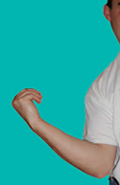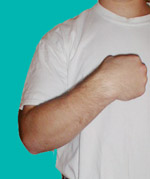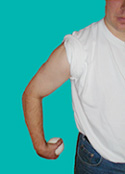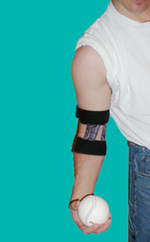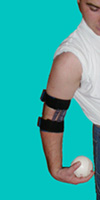Fastpitch
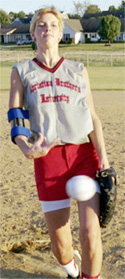
How the ThrowMAX works for Fastpitch
The biggest problem pitchers/coaches/instructors face when it comes to teaching pitching is to have their players focus on the wrist snap with the "junk" pitches. When we designed the ThrowMAX brace it was originally intended for overhand throwing. However, Cindy Bristow - head coach of the Florida Wahoos, WPSL - was actually the individual who determined that the ThrowMAX is extremely useful to help players feel what their arms and wrist should be doing on every throw. Just like the overhand throwing, if used long enough, players would develop muscle memory for the arm and wrist on their pitches.
.
The wrist snap is what leads to a better rotation on the ball therefore, better movement on the pitch.
Most players use the brace for the rise, drop, circle change, and screwball - some use it for the curve but it depends on personal preference.
Below are several pictures showing what happens if players curl their arms on pitches instead of using the wrist. Basically, a player does not only end up with a sloppy pitch, but they also put alot of strain on the shoulder, elbow, and wrist.
|
|
|
|
|
|
|
|
|
|
|
|
|
|
|
|
Pitchers can freely move the arm up and out
|
Curling the arm up and in after a pitch
|
Chicken Wing or bending of the elbow prior to the pitch - causes a loss of power and can put strain on the arm/shoulder
|
|
|
|
|
|
|
|
|
|
|
NOTE*** One picture not shown is how the brace will not allow the pitchers arm to curl over the top of the
head. It has the player create a true windmill motion and maximize all available power.
|
|
|
|
With the ThrowMAX:
With a quick and simple adjustment of the brace on the arm (see Putting it on and Size Chart), any pitcher will suddenly realize that they can't short-cut the wind-up, raise the shoulder to make the chicken wing, or curl their arm on the follow-through which makes the wrist do the work.
|
|
With the ThrowMAX:
With a quick and simple adjustment of the brace on the arm (see Putting it on and Size Chart), any pitcher will suddenly realize that they can't short-cut the wind-up, raise the shoulder to make the chicken wing, or curl their arm on the follow-through which makes the wrist do the work.
|
|
|
|
|
|
|
|
|
|
|
|
Notice in this photo that the player cannot curl the arm up as show in some of the above photos. The wrist is bent showing the release point is down low by the hip or in front/side of the body.
|
|
This picture shows that the player is still able to rotate the arm/shoulder either inside or outside of the body.
It also shows the inability to create the chicken wing on the forward motion of the arm.
|
|

